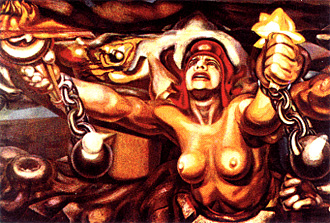
|  |  |  Editorials | October 2008 Editorials | October 2008  
Democracy Under Construction
 Jason Lakin - Harvard Review Jason Lakin - Harvard Review
go to original


| David Alfaro Siquieros - The New Democracy, 1944
Palace of Fine Arts, Mexico City | | |
In 2006, when supporters of Mexico’s Andrés Manuel López Obrador (AMLO), then candidate for the leftist PRD, took to the streets to protest alleged vote fraud during the presidential elections, many carried banners that said “Democracy Under Construction.” The implication was clear: democracy at the institutional level, where elections were organized and votes counted, was not working. Real democracy was happening in the streets, where the people were organizing and raising their voices against these same institutions.

This “institutions versus the people” dichotomy in Mexican democracy is the most important legacy of the 2006 election. It continues to define the ideology of AMLO and his supporters up to the present. Last week, speaking about the energy reform which was approved by the Mexican Senate, AMLO said that what mattered was not what the legislature said, but what “we decide, the people.”

The logic is familiar to analysts that distinguish between republicanism (rule by democratic institutions, indirectly controlled by the people) and democracy (rule by the people directly). Though we most often use the term democracy in everyday discussions of regime type, what we usually mean is republicanism: rule by democratic institutions. No one believes that rule by institutions is a panacea. Advocates of direct democracy are correct to note that institutions frequently deviate from the will of the people, pursuing their own interests instead. On the other hand, advocates of republicanism presume, also correctly, that direct democracy is neither more realistic nor necessarily fairer than rule by institutions. Republicans point out that democratic publics are easily swayed by dangerous group-think, which, in the absence of institutions that force deliberation, can lead to the repression of minorities, and the prioritization of short-term gains over long-term development.

In general, the relevant question in a republic is whether or not republican institutions are legitimate. When institutions are legitimate, which minimally requires fair elections, then we tend to think that these institutions should be respected, even if we allow citizens to protest, file lawsuits, or lobby to change decisions made by them. What happens, however, when the institutions are not legitimate? This is the position taken by AMLO and his followers, who argued that the 2006 elections were illegitimate because the institutions that organized them were illegitimate, and because the process was not free and fair.

There is no question that AMLO’s attack on Mexican republican institutions is self-serving. However, whether AMLO is motivated by self-interest or not, many Mexicans do doubt the legitimacy and efficacy of their institutions. The only solution to widespread doubts about the legitimacy of institutions is the re-foundation of those institutions with renewed legitimacy, not, as Mexican conservatives sometimes seem to believe, to repeatedly restate that institutions are legitimate because they are institutions.

In fact, Mexico’s legislators are slowly achieving institutional renewal. The PAN (the president’s party) and the PRD were able to reach a consensus earlier this year to renew the leadership of the electoral institute (IFE), whose credibility was severely damaged in 2006. Although President Calderón was among the worst purveyors of the “institutions exist therefore they are legitimate” doctrine during the 2006 elections, he has pursued negotiation and consensus-building on key initiatives, such as fiscal and now energy policy. The result has been limited reform, but increasingly legitimate procedures for arriving at it.

The biggest threat to Mexico’s institutional renewal today comes from a different source: the spiraling corruption engendered by the war on drugs. Today, El Universal reports that officials working for SIEDO, a special government office dedicated to investigating organized crime, have been on retainer for the drug lords since at least 2004. These officials, who earned as much as US$450,000 per month, passed along government information to one of Mexico’s most notorious cartels, that of the Beltrán Leyva brothers. The revelations were the result of the government’s own Operation Cleanup, which means, of course, that they represent a double-edged sword. On the one hand, they should increase confidence that the government is functioning to police its own abuses. On the other, they reinforce the perception that the government is riddled with corruption, so much so that the war on drugs is doomed to failure.

Young democracies frequently struggle to renovate a large number of weak institutions all at once, but many do survive. The renovation of institutions is a tricky business, and there are plenty of reasons to worry that Mexico is not up to the task. But if there is one thing Mexicans proved during the twentieth century, it is that they are exceptionally creative at reinventing institutions. The one-party regime waxed and waned, but it survived intact for decades by adapting to radically changing international and domestic circumstances. Mexico’s leaders have demonstrated, since the crisis of confidence in 2006, a surprising ability to work together to avoid the worst. Many more surprises will be needed to push the country’s democratization forward. On this gloomy Monday, overshadowed by the disillusion of new corruption allegations, the country’s leadership may look down, but I wouldn’t count them out. |

 |
|  |



